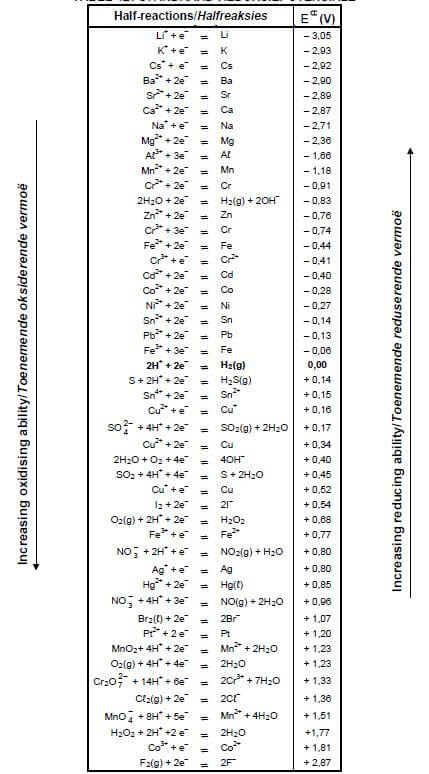PHYSICAL SCIENCES: CHEMISTRY PAPER 2 GRADE 12 QUESTIONS - AMENDED SENIOR CERTIFICATE EXAMS PAST PAPERS AND MEMOS MAY/JUNE 2018
Share via Whatsapp Join our WhatsApp Group Join our Telegram GroupPHYSICAL SCIENCES: CHEMISTRY
PAPER 2
GRADE 12
AMENDED SENIOR CERTIFICATE EXAMS
PAST PAPERS AND MEMOS
MAY/JUNE 2018
INSTRUCTIONS AND INFORMATION
- Write your centre number and examination number in the appropriate spaces on the ANSWER BOOK.
- This question paper consists of TEN questions. Answer ALL the questions in the ANSWER BOOK.
- Start EACH question on a NEW page in the ANSWER BOOK.
- Number the answers correctly according to the numbering system used in this question paper.
- Leave ONE line between two subquestions, for example between QUESTION 2.1 and QUESTION 2.2.
- You may use a non-programmable calculator.
- You may use appropriate mathematical instruments.
- You are advised to use the attached DATA SHEETS.
- Show ALL formulae and substitutions in ALL calculations.
- Round off your final numerical answers to a minimum of TWO decimal places.
- Give brief motivations, discussions, et cetera where required.
- Write neatly and legibly.
QUESTIONS
QUESTION 1: MULTIPLE-CHOICE QUESTIONS
Various options are provided as possible answers to the following questions. Choose the answer and write down only the letter (A-D) next to the question numbers (1.1 to 1.10) in the ANSWER BOOK, e.g. 1.11 D.
1.1 An example of a saturated organic compound is …
- ethyne.
- propene.
- but-2-ene.
- 2-chloropropane. (2)
1.2 When ethene reacts with hydrogen gas in the presence of a catalyst, the product is …
- ethane.
- ethyne.
- ethanol.
- ethanal. (2)
1.3 Study the structural formula of the functional group below.
The structure above is the functional group of …
- esters.
- ketones.
- aldehydes.
- carboxylic acids. (2)
1.4 The potential energy graph for a hypothetical chemical reaction is shown below.
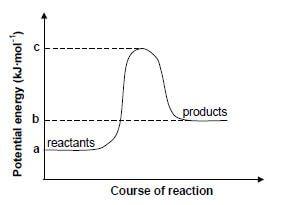
What type of reaction is taking place and what are the correct methods to calculate ΔH and Ea? (2)
| ΔH | Ea | ||
| A | Exothermic | b − a | c − b |
| B | Endothermic | b − a | c − a |
| C | Endothermic | a − b | a − c |
| D | Exothermic | a − b | b − c |
1.5 Study the hypothetical reaction below:
2P(g) + 3Q(g) → 4R(g) + 2Z(g)
The rate of the reaction in terms of the number of moles of substance P used up, is 1 x 10-3 mol∙dm-3∙s-1. What is the rate (in mol∙dm-3∙s-1) at which product R is formed?
- 1×10−3
- 4(1×10-3)
- 1×10-3
2 - 2(1 × 10-3) (2)
1.6 Study the following reaction at equilibrium at a certain temperature.
2SO3(g) ⇌ O2(g) + 2SO2(g) ΔH > 0
Which ONE of the following factors will change the Kc value?
- Adding more SO2(g).
- Adding a catalyst.
- Increasing the temperature.
- Increasing the pressure by decreasing the volume. (2)
1.7 Which ONE of the following represents the products formed during the hydrolysis of NH+4 (aq)?
- NH3(aq) + H2O(ℓ)
- NH3(aq) + H3O+(aq)
- NH3(aq) + OH-(aq)
- NH3(aq) + OH-(aq) + H2O(ℓ) (2)
1.8 Potassium nitrate is used as an electrolyte in the salt bridge of a copper-zinc cell. Which ONE of the following CORRECTLY shows the direction of migration of potassium and nitrate ions in the cell? (2)
| POTASSIUM IONS TO THE: | NITRATE IONS TO THE: | |
| A | Anode | Cathode |
| B | Negative electrode | Positive electrode |
| C | Zinc electrode | Copper electrode |
| D | Copper electrode | Zinc electrode |
1.9 Which ONE of the following shows the electrode where the electrons are gained in an electrolytic cell and the chemical change that occurs at this electrode? (2)
| ELECTRODE WHERE ELECTRONS ARE GAINED | CHEMICAL CHANGE | |
| A | Anode | Oxidation |
| B | Anode | Reduction |
| C | Cathode | Oxidation |
| D | Cathode | Reduction |
1.10 The industrial preparation of nitric acid is known as the …
- Haber process.
- contact process.
- Ostwald process.
- catalytic oxidation of ammonia. (2) [20]
QUESTION 2 (Start on a new page.)
Next to each letter, A to F, in the table below is the molecular formula of an organic compound.
A | C2H5Br | B | C2H4 |
C | C4H10 | D | C2H6O |
E | C3H6O | F | C3H6O2 |
2.1 Choose a molecular formula above that represents an organic compound below. Write down only the letter (A to F) next to the question numbers (2.1.1 to 2.1.5), e.g. 2.1.6 G.
2.1.1 A haloalkane (1)
2.1.2 An alcohol (1)
2.1.3 An unsaturated hydrocarbon (1)
2.1.4 An aldehyde (1)
2.1.5A product of thermal cracking of compound C (1)
2.2 If compound F is a carboxylic acid, write down the following:
2.2.1 The structural formula of a FUNCTIONAL isomer of F (2)
2.2.2 The IUPAC name of a FUNCTIONAL isomer of F (2)
2.3 Compound B is a monomer used to make a polymer. Write down the:
2.3.1 Definition of a polymer (2)
2.3.2 IUPAC name of the polymer (1)
2.3.3 Balanced equation for the polymerisation reaction (3)
2.4 Compound A is used as a reactant in the production of compound D.Name the type of reaction that takes place. (1)
2.5 State TWO changes that can be made to the reaction conditions in QUESTION 2.4 to obtain compound B, instead of D, as product. (2) [18]
QUESTION 3 (Start on a new page.)
The boiling points of straight-chain alkanes and straight-chain alcohols are compared in the table below.
NUMBER OF CARBON ATOMS | BOILING POINTS OF ALKANES (°C) | BOILING POINTS OF ALCOHOLS (°C) |
1 | - 162 | 64 |
2 | - 89 | 78 |
3 | - 42 | 98 |
4 | - 0,5 | 118 |
3.1 Explain the increase in boiling points of the alkanes, as indicated in the table. (3)
3.2 Explain the difference between the boiling points of an alkane and an alcohol, each having THREE carbon atoms per molecule, by referring to the TYPE of intermolecular forces. (4)
3.3 Does the vapour pressure of the alcohols INCREASE or DECREASE with an increase in the number of carbon atoms? (1)
3.4 How will the boiling point of 2-methylpropane compare to that of its chain isomer? Write down HIGHER THAN, LOWER THAN or EQUAL TO. Give a reason for the answer by referring to the structural differences between the two compounds. (2) [10]
QUESTION 4 (Start on a new page.)
Propan-1-ol can undergo a number of organic reactions, as indicated by the letters A to D in the diagram below.
4.1 Write down the type of reaction represented by:
4.1.1 A (1)
4.1.2 B (1)
4.1.3 C (1)
4.1.4 D (1)
4.2 For reaction C, write down the:
4.2.1 Function of H2SO4 (1)
4.2.2 IUPAC name of the organic product (2)
4.2.3 Structural formula of the other organic reactant (2)
4.3 Use STRUCTURAL FORMULAE for all organic reactants and products to write a balanced equation for reaction A. (5) [14]
QUESTION 5 (Start on a new page.)
Two experiments are carried out to investigate one of the factors that affects the reaction rate between magnesium and dilute hydrochloric acid. The balanced equation below represents the reaction that takes place.
Mg(s) + 2HCℓ(aq) → MgCℓ2(aq) + H2(g)
In experiment 1 a certain mass of magnesium ribbon reacts with excess dilute hydrochloric acid. In experiment 2 magnesium powder of the same mass as the magnesium ribbon, reacts with the same volume of excess dilute hydrochloric acid. The concentration of the acid is the same in both experiments.
The apparatus below is used for the investigation.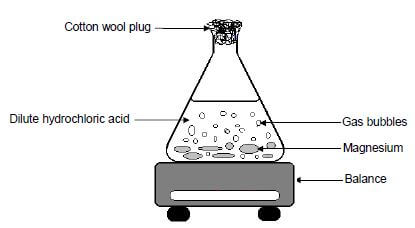
5.1 Define reaction rate. (2)
5.2 For this investigation, write down the:
5.2.1 Independent variable (1)
5.2.2 Control variable (1)
The change in mass of magnesium is calculated and recorded in 2-minute intervals for both experiments. The results obtained are shown in the graph below (NOT drawn
to scale).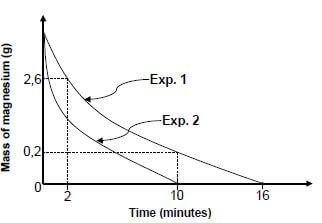
5.3 Use the information on the graph to:
5.3.1 Calculate the volume of hydrogen gas produced in experiment 1 from t = 2 minutes to t = 10 minutes Take the molar gas volume as 25 dm3∙mol-1. (5)
5.3.2 Calculate the initial mass of magnesium used if the average rate of formation of hydrogen gas in experiment 2 was 2,08 x 10-4 mol∙s-1 (5)
5.4 Use the collision theory to explain why the curve of experiment 2 is steeper than that of experiment 1. (3) [17]
QUESTION 6 (Start on a new page.)
The equation below represents a hypothetical reaction that reaches equilibrium in a closed container after 2 minutes at room temperature. The letters x, y and z represent the number of moles in the balanced equation.
xA(aq) + yB(aq) ⇌ zC(aq)
The graph below shows the change in the number of moles of reactants and products versus time during the reaction.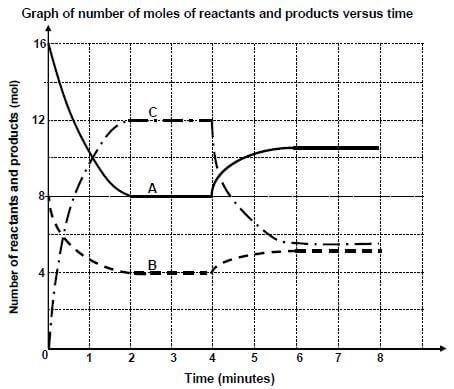
6.1Define a dynamic equilibrium. (2)
6.2 Use the information in the graph and write down the value of:
6.2.1 x (1)
6.2.2 y (1)
6.2.3 z (1)
6.3 Calculate the equilibrium constant, Kc, for this hypothetical reaction at room temperature if the volume of the closed container is 3 dm3. (7)
6.4 At t = 4 minutes, the temperature of the system was increased to 60 °C. Is the REVERSE reaction EXOTHERMIC or ENDOTHERMIC? Explain how you arrived at the answer. (3) [15]
QUESTION 7 (Start on a new page.)
The reaction between a sulphuric acid (H2SO4) solution and a sodium hydroxide (NaOH) solution is investigated using the apparatus illustrated below.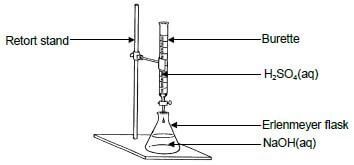
7.1 Write down the name of the experimental procedure illustrated above. (1)
7.2 What is the function of the burette? (1)
7.3 Define an acid in terms of the Arrhenius theory. (2)
7.4 Give a reason why sulphuric acid is regarded as a strong acid. (1)
7.5 Bromothymol blue is used as indicator. Write down the colour change that will take place in the Erlenmeyer flask on reaching the endpoint of the titration.
Choose from the following:
BLUE TO YELLOW YELLOW TO BLUE GREEN TO YELLOW (1)
During the titration a learner adds 25 cm3 of NaOH(aq) of concentration 0,1 mol·dm-3 to an Erlenmeyer flask and titrates this solution with H2SO4(aq) of concentration 0,1 mol·dm-3. The balanced equation for the reaction that takes place is:
2NaOH(aq) + H2SO4(aq) → Na2SO4(aq) + 2H2O(ℓ)
7.6 Determine the volume of H2SO4(aq) which must be added to neutralise the NaOH(aq) in the Erlenmeyer flask completely. (4)
7.7 If the learner passes the endpoint by adding 5 cm3 of the same H2SO4(aq) in excess, calculate the pH of the solution in the flask. (7) [17]
QUESTION 8 (Start on a new page.)
8.1 Consider the electrochemical cell represented by the cell notation below,
where X is an unknown metal:
Pt(s) | Fe2+(aq), Fe3+(aq) || X+(aq) | X(s)
The cell potential of this cell was found to be 0,03 V.
8.1.1 Write down the type of electrochemical cell illustrated above. (1)
8.1.2 What does the single line (|) in the above cell notation represent? (1)
8.1.3 Write down the half-reaction that takes place at the anode in the above cell. (2)
8.1.4 Identify X with the aid of a calculation. (5)
8.2 A Pt(s) | Fe2+(aq), Fe3+(aq) half-cell is connected to a Cu(s) | Cu2+(aq) half- cell.
Write down the:
8.2.1 Chemical symbol for the electrode in the cathode half-cell (1)
8.2.2 NAME of the oxidising agent (1)
8.2.3 Overall balanced cell reaction that takes place in this cell (3) [14]
QUESTION 9 (Start on a new page.)
The diagram below shows an electrolytic cell used to electroplate an iron rod with COPPER. Solution X is made up of an unknown NITRATE.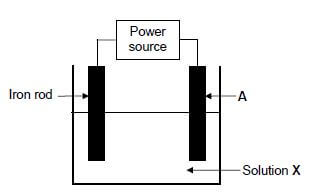
9.1 Solutions, such as solution X, are always used in electrochemical cells.
9.1.1 Write down the general term used to describe these solutions. (1)
9.1.2 What is the function of these solutions in electrochemical cells? (1)
9.2 Write down the FORMULA of solution X. (1)
9.3 Which electrode (A or IRON ROD) is the negative electrode? Give a reason for the answer. (2)
9.4 Write down the half-reaction that takes place at electrode A. (2)
9.5 Electrode A is now replaced by a silver rod without making any other changes to the cell. After a while, TWO metallic ions are found to be present in the solution.
9.5.1 Name the TWO metallic ions present in the solution. (2)
9.5.2 Refer to the relative strengths of oxidising agents to explain which ONE of the two ions will preferably be involved in the plating process. (2) [11]
QUESTION 10 (Start on a new page.)
The flow diagram below shows the steps used to prepare fertilisers X and Y. Labels I and II represent types of chemical reactions and P is a compound.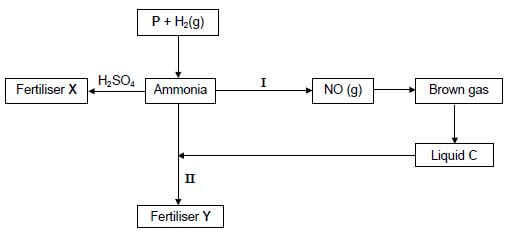
10.1 Write down the NAME of the reaction labelled:
10.1.1 I (1)
10.1.2 II (1)
10.2 Write down the NAME or FORMULA of:
10.2.1 Compound P (1)
10.2.2 The brown gas (1)
10.2.3 Liquid C (1)
10.3 Write down a balanced equation for:
10.3.1 The preparation of fertiliser X (3)
10.3.2 Reaction I (3)
10.4 Fertiliser Y is ammonium nitrate. Calculate the mass percentage of nitrogen in fertiliser Y. (3) [14]
TOTAL: 150
NATIONAL SENIOR CERTIFICATE
DATA FOR PHYSICAL SCIENCES GRADE 12 PAPER 2 (CHEMISTRY)
TABLE 1: PHYSICAL CONSTANTS
| NAME | SYMBOL | VALUE |
| Standard pressure | pθ | 1,013 x 105 Pa |
| Molar gas volume at STP | Vm | 22,4 dm3∙mol-1 |
| Standard temperature | Tθ | Tθ 273 K |
| Charge on electron | e | e -1,6 x 10-19 C |
| Avogadro’s constant | NA | NA 6,02 x 1023 mol-1 |
TABLE 2: FORMULAE
n = m | n = N NA |
| c = n V or c = m MV | n = V Vm |
| caVa= na cbVb nb | pH= -log[H3O+] |
| Kw = [H3O+][OH-] = 1x10-14 at 298K | |
| Eθ cell = Eθ cathode – Eθ anode Eθ cell = Eθ reduction – Eθ oxidation Eθ cell = Eθ oxidising agent – Eθ reducing agent |

TABLE 4A: STANDARD REDUCTION POTENTIALS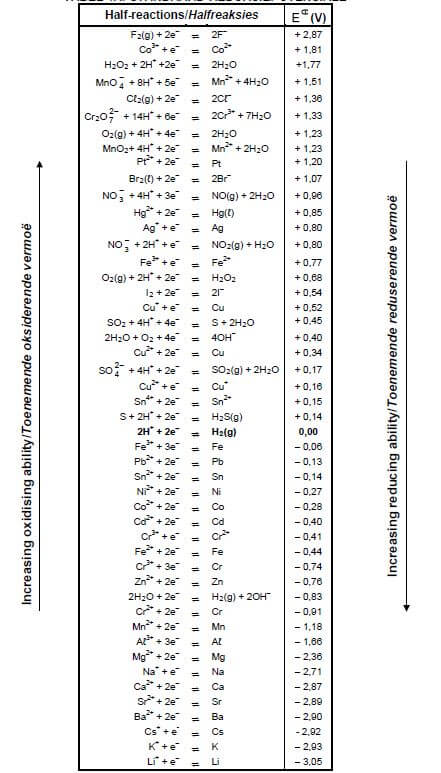
TABLE 4B: STANDARD REDUCTION POTENTIALS